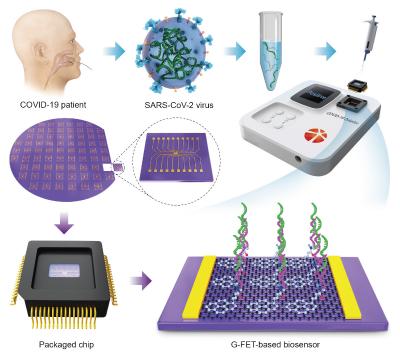A research team at South China University of Technology, Peking University and other China-based universities have developed an accurate, rapid, and portable electrical detector based on the use of graphene field-effect transistors (G-FETs) for detection of RNA from COVID-19 patients.

The detection system consists of two main parts: a plug-and-play packaged biosensor chip and an electrical measurement machine. The unique feature of this method is that the extent of hybridization between the ss-DNA probe and viral RNA can be directly converted to the current change of graphene channels without repetition of the PCR process. Furthermore, this method was validated using clinical samples collected from many patients with COVID-19 infection and healthy individuals as well, and the testing results were in full agreement with those of PCR-based optical methods.
The entire process, precluding the extraction of detection targets from oropharyngeal swabs, requires approximately 10 min. Because it does not involve time-consuming PCR steps nor expensive instruments, this detection system enables massive point-of-care testing of COVID-19, outside of specialized diagnostic laboratories, with the advantage of high accuracy, sensitivity and low cost.
Notably, false negative results are inevitable in the course of nucleic acid testing; thus, the use of immunodetection as an auxiliary technique is important in the diagnosis of COVID-19 patients, especially those with suspected diseases. By replacing the ss-DNA probe with a SARS-CoV-2 antigen protein, this detection system can also detect SARS-CoV-2 IgM and IgG antibodies with an ultra-low LOD. Immunoassays of serum specimens of COVID-19 patients and healthy subjects matched excellently with those of PCR-based optical methods.
This detecting system exhibits obvious advantages of high sensitivity, rapid speed (around 10 min for RNA analysis and 5 min for immunoassay), and bifunction (both RNA analysis and immunoassay). These advantages enable high-throughput point-of-care testing, which may facilitate management of the current severe public health crisis. Furthermore, this detection system offers a universal methodology that is ready for immediate application in rapid detection of novel viruses in future.